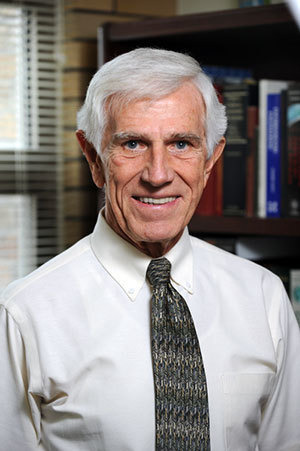 Roger A. Schmitz
Roger A. Schmitz
Roger A. Schmitz, professor emeritus of chemical and biomolecular engineering at the University of Notre Dame, died at his home in South Bend Friday (Oct. 11) after a courageous and dignified struggle with amyotrophic lateral sclerosis, also known as ALS or Lou Gehrig’s disease. He was 78.
A native of Carlyle, Ill., Schmitz graduated from the University of Illinois in 1959 with a degree in chemical engineering and earned his Ph.D. from the University of Minnesota in 1962. He was a member of the chemical engineering faculty at the University of Illinois from 1962 to 1979.
Schmitz joined the Notre Dame faculty in 1979 as Keating-Crawford Professor and was named chairman of the chemical engineering department the same year. Already internationally known for his research on instabilities in chemically reacting systems, he would be elected to membership in the prestigious National Academy of Engineering five years later.
From 1981 to 1987, Schmitz served as McCloskey Dean of Notre Dame’s College of Engineering before being appointed vice president and associate provost. Among his many duties in that post, Schmitz was charged with the development of campuswide computing and information technologies, an area in which Notre Dame made enormous strides during his eight-year tenure, including the wiring of all student residences for access to the campus computing network. Despite his conspicuous acumen for academic administration, he often said, “When I first entered academic administration as a department chair, I didn’t intend it to be my life’s work.” When he returned to full-time teaching and research in 1995, it was with obvious delight. One of the graduate students in Schmitz’s laboratory recalled his standing promise to treat the group to a Cubs game at Wrigley Field, but not until “their infrared imaging studies reveal some critical new knowledge about catalyst behavior. One breakthrough that might send them all to the game would be the observation of interacting oscillating spots or standing patterns arising from spatial instabilities.”
Schmitz continued as Keating-Crawford Professor emeritus from 2005 until his death.
He had accumulated a succession of national teaching and research awards over the years. In addition to a 1968-69 Guggenheim Fellowship, he had received the R.H. Wilhelm Award from the American Institute of Chemical Engineers, the American Society of Engineering Education’s George Westinghouse Award and the Allan P. Colburn Award of the American Institute of Chemical Engineers. He was clearly proud of these things, but when an interviewer once asked him what mattered most to him, he paused for a moment before speaking decisively: “There’s no question. The most important thing in the world is my family. That’s where my pride and satisfaction are centered. As far as work is concerned, I like to feel that I’m doing something interesting and important, that someone’s benefiting from what I do and that my work is more than merely a job. Accumulating awards is not one of my priorities.” Then, laughing, he added, “I’ll accept an award or prize anytime anyone wants to give one to me, but it’s not a big thing to me. My happiness and fulfillment don’t depend on it.”
That family on which his happiness and fulfillment did indeed depend surrounded Schmitz as he died Friday in their home on Londonberry Lane. He had married Ruth Kuhl in 1957. She survives him, along with their daughters, Jan (Rick) Mathew of Forsyth, Ill.; Joy (Mark) Barnes of Houston; and Joni (Paul) Sabin, New Berlin, Wis.; granddaughters, Amanda Ruth Mathew, Rachel Suzanne Barnes and Hannah Catherine Barnes; and grandsons, Troy Richard Mathew, Timothy Roger Sabin, Todd Christian Sabin and Tyler Francis Sabin.
A Mass of Christian burial will be held at 3:30 p.m. Wednesday (Oct. 16) in Notre Dame’s Basilica of the Sacred Heart. A visitation is scheduled for two hours prior, from 1:15 to 3:15 p.m.